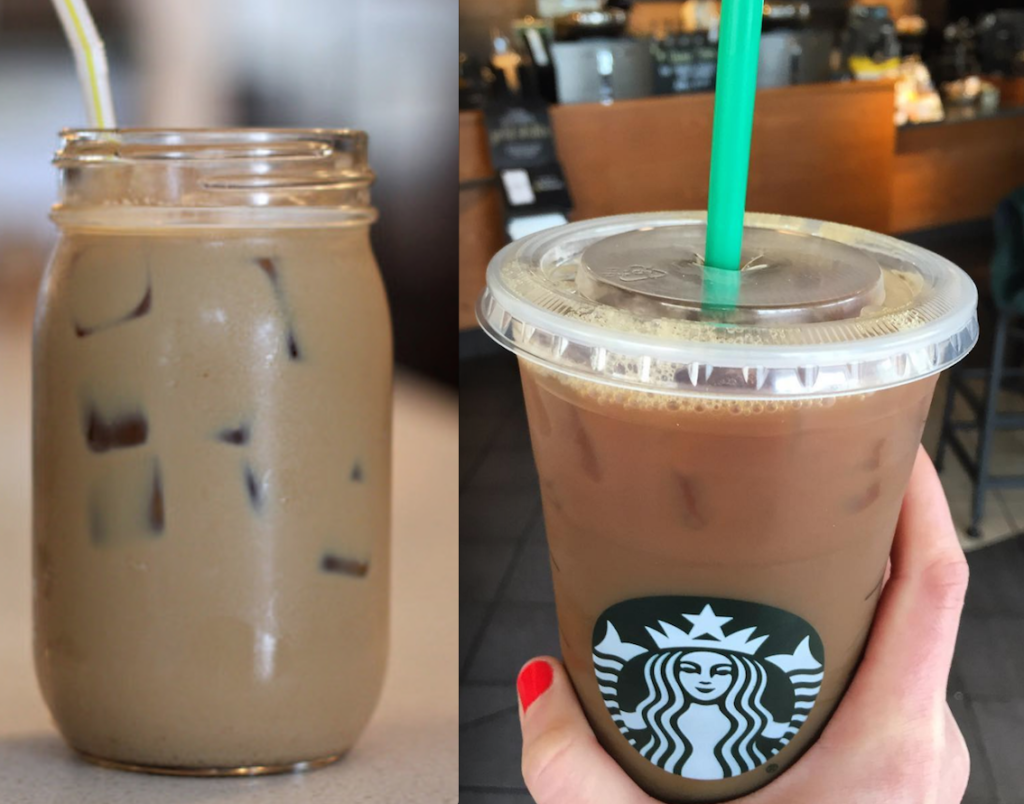If you’ve heard of coffee, you’ve heard of iced coffee. If you’re mildly addicted, you’ve heard of cold brew. Here is a great photo comparing coffee and cold brew:

Photos by Gabby Phi and Catherine Curran
Great. So what we’ve learned so far is that there seems to be no difference? Wrong. There are plenty of differences and here are some of them.
How It’s Made
Iced Coffee
You shouldn’t need a degree to figure this one out, it’s coffee over ice. Unfortunately, if that’s your method, the coffee will taste watered down and gross. Sometimes to combat this people will brew the coffee twice as strong, so that the ice hopefully does water it down. However, there are a few other methods to making your own iced coffee.
You can brew regular coffee and then cool it in the fridge over night and pour it over ice the next day.
You can use a drip method, also known as the Japanese method, where you brew a very strong batch of coffee poured drop by drop over ice which cools the coffee immediately and dilutes the strength the proper amount.
You can also crash-cool it where you brew it hot and then pour the coffee into a container with good heat conduction, like a cocktail shaker. Then just stick the container into ice water and stir for a few minutes.
Cold Brew
Cold brew also has a few methods. The basics behind it are coffee grounds that are steeped in cold or room temperature water for 12-24 hours (perfect to make overnight) and then filtered with your preferred method. This produces a concentrate which you then add your preferred amount of water to and voila you have cold brew.
You can use a milk bag and fill it with course coffee grounds of your choosing. Take that bag and place it in a pitcher filled with water and put it in the fridge over night (or leave it in there for 12 hours during the day). To drink, simply remove the bag and mix the coffee concentrate with water using a 1:1 ratio. Or don’t, I don’t know your life.
You can also use a French Press, if you’re fancy and have a French Press. So add your ground coffee into the FP, and cover it with cold or room temp filtered water, making sure all of the grounds are wet. Now cover and leave overnight or 12 hours. After this, plunge the coffee like you would normally
But what if you just have a mason jar? No problem. Go with a more coarsely ground coffee so that the filtering process is easier. So still put your grinds in water again and fill up the mason jar. Put your lid on and stick it in the fridge. When you take it out, filter that bitch. I’m sorry. But filter it with whatever method you prefer to remove the grinds, in fact, do it twice just to make sure it’s really all filtered out.
If it were up to me, I think the easiest method is brewing hot coffee and letting it sit overnight or using the milk bag method over night. Although the fastest method seems to be crash cooling hot coffee to make it cold.
Acidity
Iced Coffee
Because iced coffee is often brewed at the normal 195-200 degree temperature and then cooled down, the high temperatures are responsible for extracting particular acids and oils that produce that bitter taste. Cream or milk and sugar often combat this issue, and personally, adding a bit of cinnamon often cuts the acidity nicely. But of course, you’re adding calories when you add that milk or cream and sugar.
Cold Brew
Cold brew coffee is brewed with time, not temp, so those acids and oils aren’t extracted which leads to a much smoother drink, supposedly 67% less acidic than iced coffee. However, some believe that certain solubles from the coffee that can only be extracted with high temperatures lead to a fuller body.
If it were up to me, I prefer the taste of cold brew over iced coffee and I agree that it goes down much smoother. However, I’m also not a coffee or bean master so if you want to tell me it doesn’t have a full-bodied taste, I support you.
Taste
Iced Coffee
Iced coffee, due to the brewing at high temperatures bringing out specific solubles thing, often has more cola or caramel like undertones to it that cold brew is unable to achieve at the low temp brewing levels.
Cold Brew
Cold brew supposedly has more chocolatey undertones. Award-winning barista Sam Lewtonin told Business Insider that, “What it can dissolve are the things that we think of as tasting like ‘coffee’: chocolatey, nutty, and toasty flavors.”
If it were up to me, I like the taste of cold brew. I don’t find I need to add milk or sugar because not only is it less acidic but I much prefer the chocolatey notes.
Nutrition Benefits
Iced Coffee
Let’s talk calories. Starbucks iced coffee has 80 calories with 20 grams of sugar in a 16oz grande drink. It is possible to get your iced coffee unsweetened, but as we just learned, that can leave you with a real bitter taste which is why it is often pre-sweetened for you.
Cold Brew
Starbucks cold brew has 5 calories and 0 grams added sugar in their 16oz grande drink. Also, since cold brew is less acidic than regular iced coffee, it’s easier on the digestive system which is always a pro.
Caffeine
Iced Coffee
Last but not least, the main attraction: caffeine. If you don’t make your iced coffee right, it can get pretty watered down. You can always brew it twice as strong in order to combat this dilution problem.
Cold Brew
Cold brew can have almost twice as much caffeine as iced coffee. When you make cold brew, you make an extremely concentrated coffee which you then dilute with water. Though you can control this process yourself which means you can have a much more caffeinated beverage if you use less water. In fact, some people simply drink the concentrate.
If it were up to me, when I’m getting that cup of coffee in the morning to get me through class, I’d choose the more caffeinated version. However, sometimes caffeine affects people differently and too much can make some people feel way too wired. So use discretion.


